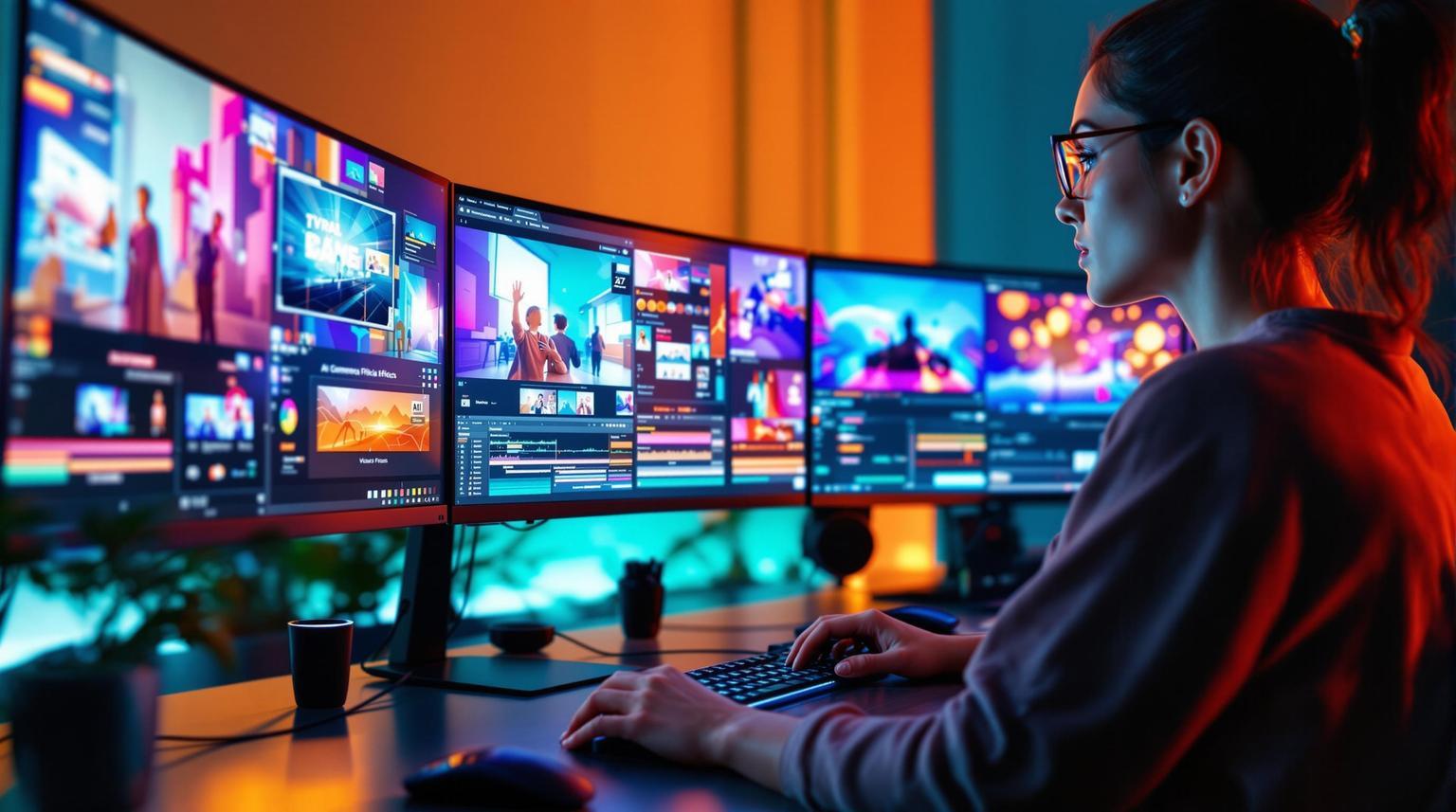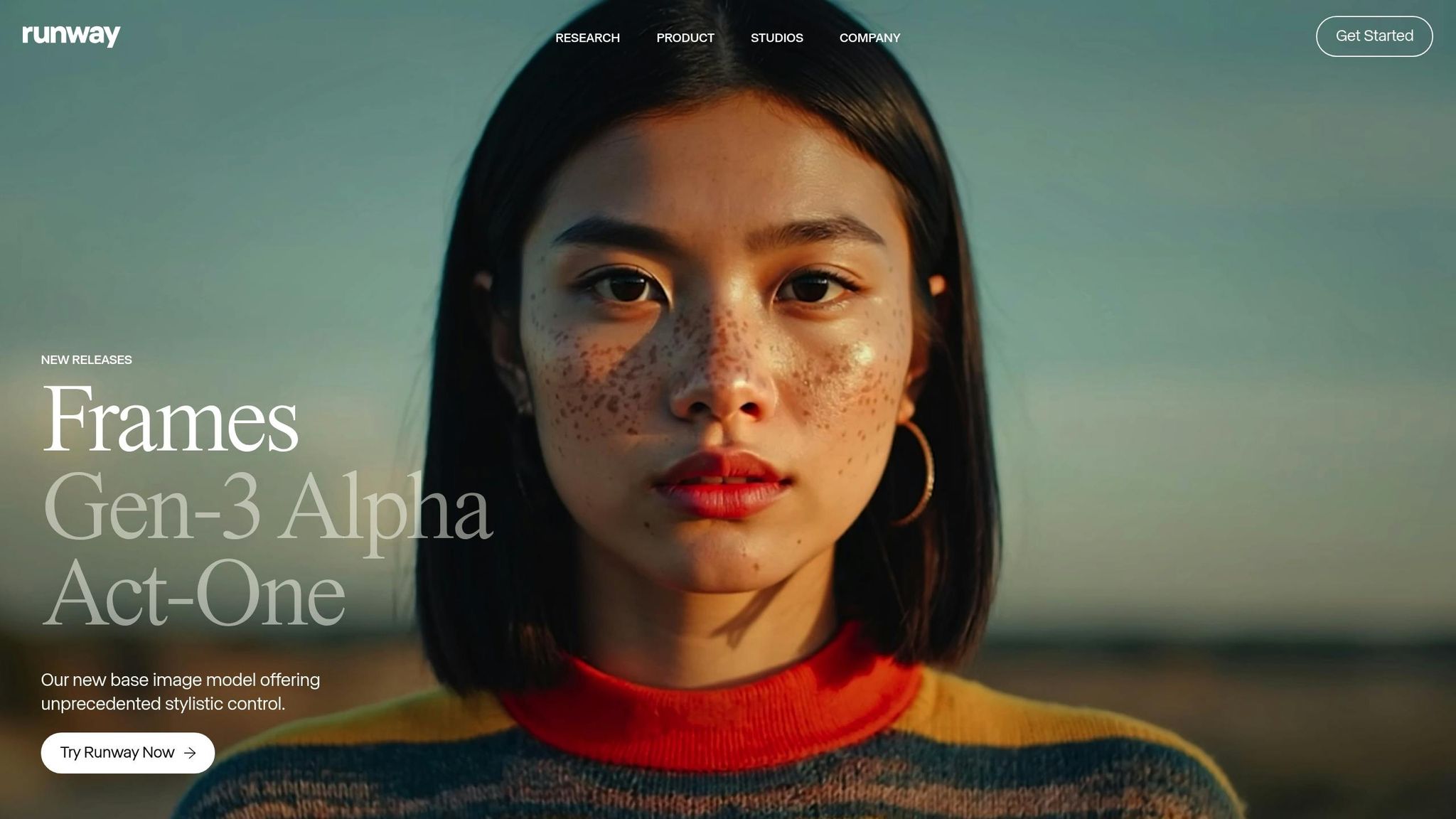
LongStories is constantly evolving as it finds its product-market fit. Features, pricing, and offerings are continuously being refined and updated. The information in this blog post reflects our understanding at the time of writing. Please always check LongStories.ai for the latest information about our products, features, and pricing, or contact us directly for the most current details.
Ultimate Guide to Virtual Camera Effects in AI Videos
Virtual camera effects powered by AI are transforming video production by saving time, reducing costs, and ensuring professional-quality results. These effects simulate camera movements, adjust visuals, and enhance backgrounds - all without expensive equipment or extensive manual editing.
Key Benefits:
- Time Savings: Create videos in minutes instead of hours.
- Creative Control: Customize motion, lighting, and transitions.
- Professional Quality: Achieve polished results with minimal effort.
- Accessibility: Ideal for content creators, marketers, educators, and businesses.
Main Effect Types:
- Motion Control: Smooth camera movements, tracking, and stabilization.
- Background Switching: Replace or enhance backgrounds without green screens.
- Visual Processing: Automatic lighting, color correction, and frame rate improvements.
Quick Comparison:
| Feature | Traditional Method | AI-Enhanced Method |
|---|---|---|
| Production Time | 10+ hours | 5 minutes |
| Customization | Manual adjustments | Automated fine-tuning |
| Equipment Needed | High-end gear | Software-based solutions |
| Consistency | Variable results | Standardized quality |
Platforms like LongStories.ai simplify video creation with AI tools for script writing, image generation, and seamless effects. Whether you're creating YouTube videos, marketing campaigns, or educational content, AI-driven virtual camera effects make the process faster and more accessible.
The NEW Ambient Motion Control in RunwayML

Virtual Camera Effects Basics
AI and Camera Effects
AI is changing how virtual camera effects are used in video production. By automating tasks like footage processing, it saves time while maintaining high-quality results.
Here’s how AI improves the process:
| Feature | Traditional Method | AI-Enhanced Method |
|---|---|---|
| Processing Time | 10+ hours per video | 5 minutes per video |
| Customization | Manual adjustments | Automated fine-tuning |
| Consistency | Variable results | Standardized quality |
| Resource Usage | Heavy equipment needed | Software-based solution |
Platforms such as LongStories.ai streamline tasks like script writing, image generation, and timing adjustments. These tools make it easier to apply advanced camera effects quickly and efficiently.
Main Camera Effect Types
AI-powered virtual camera effects generally fall into three main categories:
- Motion Control Effects: Mimic professional camera movements without needing physical equipment. AI analyzes scenes and adjusts settings for smooth, natural motion.
- Background Enhancement: Modify or replace video backgrounds in real time. This includes dynamic replacements, depth-aware tweaks, and improved scene composition.
- Visual Processing: Manage tasks like color correction, lighting adjustments, and frame rate optimization, all handled by AI systems.
AI tools make it possible to achieve polished visuals with far less manual effort. Advanced platforms even offer API integration, allowing users to automate video production at scale. These systems can apply multiple effects at once, delivering professional-quality videos without the need for lengthy post-production work.
Common Virtual Camera Effects
Background Switching
AI-powered background switching has made it easier to change video environments without the need for green screens. These tools use advanced algorithms to separate subjects from their surroundings, ensuring clean edges and consistent lighting.
Here are some common ways background switching is used:
| Video Type | Background Effect | Example Use Case |
|---|---|---|
| Educational | Virtual classroom | Interactive lessons with dynamic visual aids |
| Marketing | Product showcase | Highlighting products in various scenarios |
| Storytelling | Scene transitions | Shifting between multiple locations for narratives |
| Business | Professional settings | Virtual meetings with branded or custom backdrops |
Next, let’s look at how motion control helps create smoother, more polished footage.
Motion Control
AI motion control tools are designed to improve video quality by stabilizing and tracking movement intelligently. These features ensure your footage looks smooth and professional by analyzing movement frame by frame.
Some standout motion control capabilities include:
- Smart Object Tracking: Automatically follows moving subjects and adjusts camera motion for seamless results.
- Dynamic Stabilization: Reduces unwanted camera shake for steadier shots.
- Automated Panning: Simulates cinematic camera movements based on the scene’s layout.
With motion control ensuring smoother shots, visual enhancement tools take things further by refining the overall look of your video.
Visual Enhancement
AI-driven visual enhancement tools help elevate the quality of your videos by improving depth and lighting automatically. These effects save time and make your footage stand out.
Here are some key techniques:
1. Depth Effects
AI can simulate depth-of-field by analyzing the scene, creating a natural blur for backgrounds while keeping subjects sharp. This adds a polished, professional touch to your videos.
2. Lighting Optimization
These tools automatically adjust exposure, contrast, and color to ensure consistent lighting. They’re especially helpful for:
- Fixing underexposed footage
- Softening harsh shadows
- Setting the right mood with lighting adjustments
3. Frame Rate Enhancement
AI can interpolate frames to produce smoother motion. This is particularly useful for:
- Slow-motion sequences
- High-action scenes
- Transitions between shots
These enhancements not only improve video quality but also cut down on editing time, making the production process more efficient.
sbb-itb-94859ad
Making Videos with Virtual Camera Effects
Picking AI Video Software
When choosing AI video software for virtual camera effects, look for platforms that balance ease of use with creative control. Tools like LongStories.ai handle essential tasks automatically while giving you room to fine-tune your projects.
Here's a quick comparison of features to keep in mind:
| Feature | Basic Tools | Advanced Platforms (e.g., LongStories.ai) |
|---|---|---|
| Script Generation | Manual writing | AI-powered automation |
| Image Generation | Limited options | Multiple regeneration choices |
| Effect Control | Preset-only effects | Full customization capabilities |
| Asset Management | Limited export | Full asset downloads |
| Publishing Options | Manual export | Direct integration with YouTube |
Once you've picked a tool that aligns with your creative goals, you'll be ready to set up your camera effects.
Camera Effects Setup
Follow these three steps to set up your virtual camera effects effectively:
- Initial Configuration Use platforms like LongStories.ai to input a single prompt that outlines your creative vision. The software will generate a complete video package based on your input.
-
Effect Customization
Tailor your camera effects to match your desired style. This includes:
- Adjusting image settings to maintain a consistent look.
- Fine-tuning transition timing for seamless scene changes.
- Customizing motion effects for fluid movement.
- Applying visual tweaks systematically to enhance the overall feel.
- Quality Control Review your video package and make changes as needed. Tools like LongStories.ai let you refine individual elements without disrupting the overall flow of the video.
Once your video is polished, it's time to focus on making the effects appear natural and cohesive.
Tips for Natural-Looking Effects
To ensure your virtual camera effects look smooth and professional, keep these tips in mind:
Maintain Consistency
- Use uniform lighting across all scenes.
- Stick to similar motion patterns throughout the video.
- Ensure transitions between effects are seamless.
Avoid Common Pitfalls
- Don't overuse dramatic effects - they can distract from your video’s message.
- Keep camera movements subtle to maintain a professional look.
- Stay consistent with lighting, motion, and style to avoid jarring inconsistencies.
AI tools can help you apply your preferred style across all your videos, ensuring a polished and unified result.
New Developments in Camera Effects
Latest AI Video Tools
Modern AI platforms are changing the game, making video production faster and more accessible. These tools are reshaping how creators use virtual camera effects by simplifying complex processes and cutting down production time.
Here are some standout features offered by today's AI tools:
- AI Storytelling Agents: Systems that understand how to craft narratives and generate videos automatically.
- Automated Scene Generation: Tools that ensure style and tone remain consistent across visual sequences.
- Effect Adjustment: User-friendly interfaces that allow creators to tweak camera movements and transitions with precision.
The time savings are striking. For example, LongStories.ai can reduce video creation time from over 10 hours to just 5 minutes. These advancements aren't limited to traditional platforms - they’re opening doors for new applications across industries.
Uses Beyond YouTube
AI video tools are proving valuable in industries far beyond content creation for platforms like YouTube. Here’s how they’re being used:
| Industry | Application | Impact |
|---|---|---|
| Education | Interactive learning materials | Boosts student engagement |
| Marketing | Automated product demos | Delivers consistent brand messaging |
| Training | Simulated environments | Helps improve skill retention |
| Documentation | Process visualization | Makes technical details clearer |
Organizations can now plan and automate video production weeks in advance, ensuring consistent output without sacrificing quality. However, while these tools expand creative possibilities, they also bring up new challenges to address.
Limits and Ethics
AI-driven camera effects come with undeniable benefits, but they also introduce technical and ethical hurdles that require careful oversight.
Technical challenges include:
- High processing power needs
- Large storage requirements for high-quality files
- Bandwidth demands for rendering
Ethical concerns include:
- Being transparent about AI-generated content
- Protecting privacy in automated video production
- Using automation responsibly
"We are not another AI video generator. We create original stories that people actually want to watch, with the help of AI" – LongStories.ai
The real challenge is striking the right balance. While AI excels at handling technical tasks, human input is still essential for creative direction and ethical decision-making. By being open about their use of AI, creators can use these tools to enhance their work without replacing the human touch.
Conclusion
Key Takeaways
Virtual camera effects are transforming video production by making high-quality results more accessible. These tools save time and ensure consistent quality across projects.
| Aspect | Traditional Method | AI-Enhanced Method |
|---|---|---|
| Production Time | 10+ hours | 5 minutes |
| Creative Control | Limited by skill | Easy-to-use tools |
| Consistency | Variable | Automated quality |
| Scalability | Manual | AI-driven processes |
Thanks to advancements in AI, creators can now focus on storytelling without getting bogged down by technical challenges. These tools are designed to simplify the process while maintaining professional standards.
Getting Started with Virtual Camera Effects
If you're ready to dive in, LongStories.ai is a great place to start. It showcases how user-friendly these tools have become. Here are the available plans:
- Apprentice: Free, includes 50 credits
- Aspiring Storyteller: $9/month, 500 credits, no watermarks
- Proficient Storyteller: $49/month, 3,000 credits, access to advanced features
Once you've selected a plan, follow these steps to get started:
- Pick a platform that aligns with your goals.
- Experiment with basic effects before moving to more advanced options.
- Focus on your story while letting AI handle the technical details.
- Schedule content automatically to ensure consistent output.
